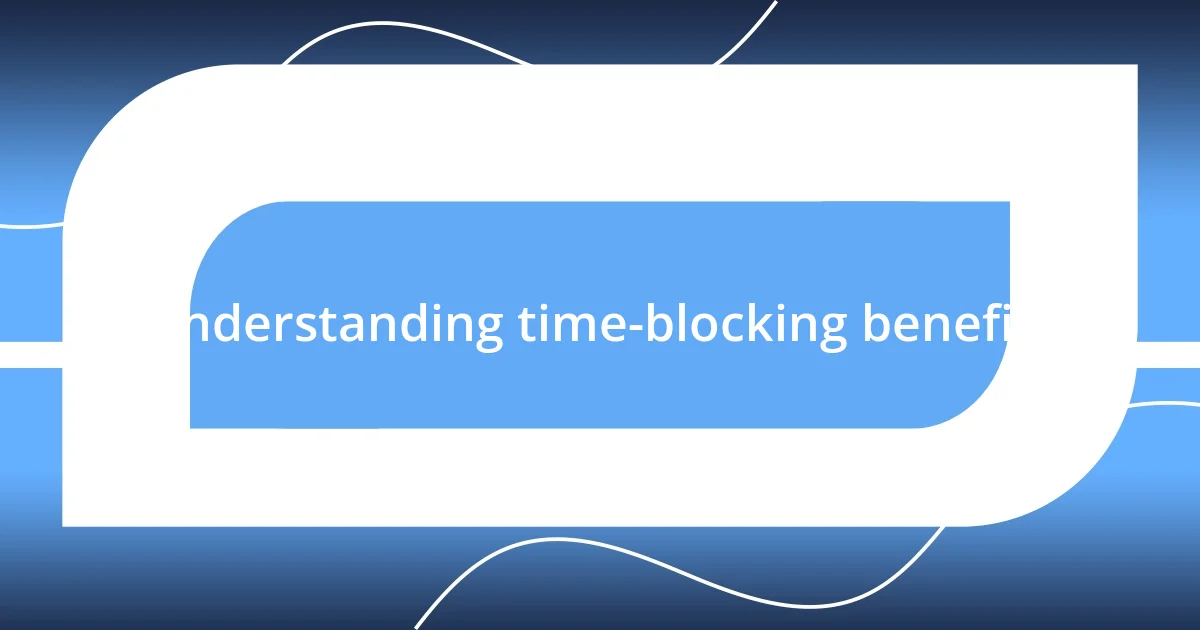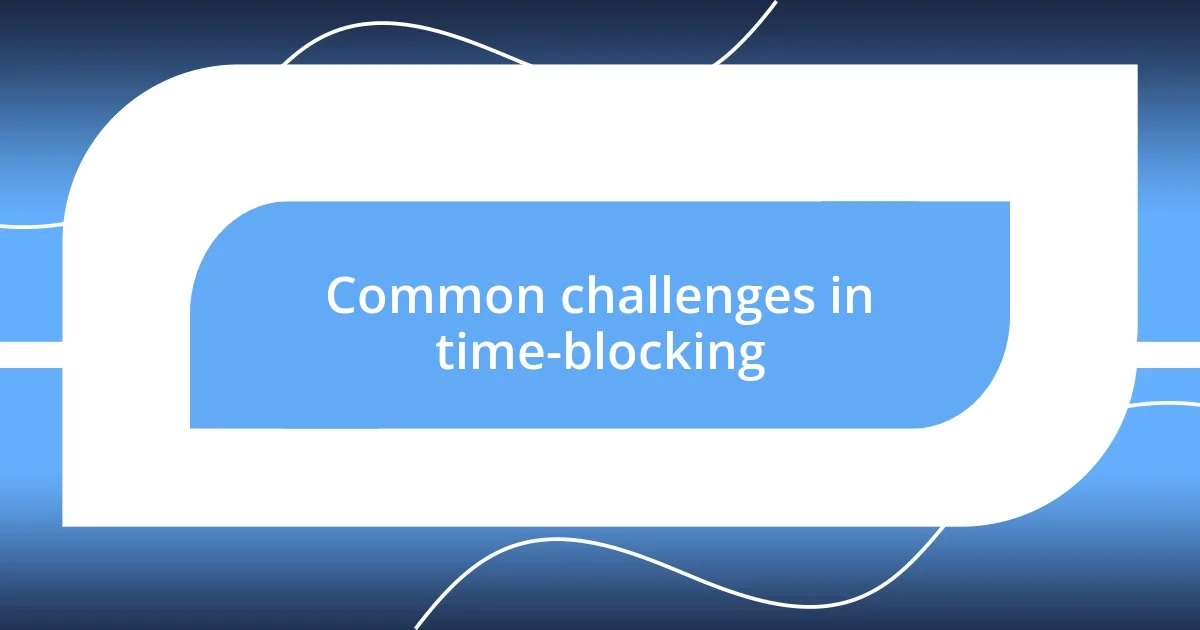Key takeaways:
- Time-blocking enhances clarity, focus, and work-life balance, aligning daily tasks with personal values.
- Effective time-blocking involves setting clear goals, taking regular breaks, and prioritizing tasks based on urgency and energy levels.
- Utilizing appropriate tools and regularly reviewing and adjusting time blocks can significantly improve productivity and reduce overwhelm.

Understanding time-blocking benefits
One of the most striking benefits of time-blocking, from my perspective, is the clarity it brings to my daily life. I remember a time when my days felt like a chaotic blur, with tasks piling up and deadlines looming. Once I started scheduling specific blocks for different activities, I felt a wave of relief wash over me; it was as if I found a roadmap amidst the confusion.
Another significant advantage I’ve noticed is how it enhances my focus. Have you ever found yourself distracted by notifications or drifting from one task to another? When I dedicated uninterrupted blocks of time to specific tasks, I experienced a remarkable boost in productivity. I often dive into a flow state that allows me to tackle complex projects with ease, making me feel both accomplished and empowered.
Lastly, time-blocking has a profound impact on my work-life balance. It’s easy to let work spill into personal time, but by blocking out periods for relaxation and hobbies, I’ve learned to protect those moments fiercely. I often ask myself, “What do I truly value?” And time-blocking helps me align my priorities with my values, ensuring I don’t just work hard, but also live well.

Key principles of effective time-blocking
One essential principle of effective time-blocking is the importance of setting clear intentions for each block. When I first started, I would just assign tasks without much thought. Over time, I learned that taking a moment to define my goal for each block transformed how I approached my day. Identifying what I aimed to achieve helped me stay focused and less overwhelmed. Here is a quick overview of this principle:
- Define specific goals for each block.
- Visualize the outcome you want to achieve.
- Adjust your blocks based on priority and energy levels.
Another key principle that I’ve embraced is the need for regular breaks within time blocks. Initially, I thought that longer stretches of productivity meant maximizing my output, but I soon realized that my mind could only sustain focus for so long. Incorporating short breaks into my schedule has been crucial. I often use this time to stretch or grab a quick cup of tea, which revitalizes my mind. This approach not only enhances my ability to concentrate but also leaves me feeling more engaged with my tasks throughout the day.

Step-by-step guide to time-blocking
To start with time-blocking effectively, I recommend outlining your daily or weekly tasks. Grab a piece of paper or use a digital tool where you can visualize your schedule. I remember my first attempt; I was too ambitious and piled on too much. However, once I broke everything down and reserved dedicated slots for smaller tasks, it felt like lifting a weight off my shoulders. This approach helped clarify what I could realistically accomplish without overloading myself.
Next, you’ll want to prioritize your blocks. I made the mistake of assigning blocks haphazardly, which led to a chaotic rhythm in my day. Instead, I found it helpful to label my blocks based on urgency and importance. This way, I could tackle significant projects when I was naturally more alert, typically in the morning. Have you ever faced a daunting project and just pushed it to the side? Believe me, assigning a focused time for it made all the difference.
Lastly, don’t forget the power of reviewing and adjusting your blocks regularly. After a week of trying out time-blocking, I took a step back and evaluated what worked and what didn’t. By being flexible and adapting to my evolving needs, I found that I could enhance my overall efficiency. When was the last time you reevaluated your routine? Giving myself that reflection time proved incredibly beneficial.
| Step | Description |
|---|---|
| 1. Outline Tasks | Identify and list tasks for the day/week, ensuring a clear view of what needs to be accomplished. |
| 2. Prioritize Blocks | Assign time blocks based on urgency and your natural energy levels to maximize productivity. |
| 3. Review and Adjust | Regularly assess your time blocks to refine your approach and improve efficiency. |

Common challenges in time-blocking
Time-blocking isn’t always a walk in the park, and one challenge I frequently faced was interruptions. I remember a particular day where every time I settled into a deep focus, a colleague would pop by to chat. It was frustrating! Have you ever experienced that? I learned the hard way that setting boundaries around my blocks was essential. I started communicating my schedule more openly, and that helped minimize disruptions.
Another hurdle in my journey was the feeling of overwhelm when a block didn’t go as planned. Picture this: I had set aside an hour for creative work, and within fifteen minutes, I felt stuck. It’s during those moments that self-doubt creeps in. I realized I needed to build flexibility into my blocks. Now, if I find myself struggling, I allow a quick reset—maybe a brief walk or a few deep breaths. It’s amazing how a simple pause can shift my mindset.
Lastly, let’s talk about unrealistic expectations. When I first started time-blocking, I packed my schedule so tightly that it felt like a race. Can you relate to that rush? I often found myself racing against the clock rather than enjoying the process. By gradually trimming my expectations and acknowledging that not everything could fit into my blocks, I began to reclaim my time and sanity. This adjustment transformed my approach and, surprisingly, improved my motivation.

Tools and apps for time-blocking
When it comes to tools for time-blocking, I’ve found that the right app can significantly enhance the experience. For instance, I used to rely heavily on Google Calendar. It was a game-changer for me. The color-coding feature allowed me to visually distinguish between different types of tasks, which made it easier to manage my time effectively. Have you ever felt overwhelmed by your schedule? I know that visual aid made a huge difference in my ability to stay on track.
Then there’s the beauty of productivity apps like Todoist or Trello. They give me the flexibility to break down larger projects into smaller, manageable tasks. I remember a particularly challenging week filled with deadlines; using Trello to create boards for each project helped me keep everything organized. I could actually see my progress, and that sense of accomplishment really motivated me. It’s fascinating how having a clear visual layout can alleviate stress—how do you feel when you see your tasks laid out like that?
Lastly, I’ve come to love dedicated time-blocking apps, such as Clockify. They not only let me plan my day but also track how much time I spend on each task. There was a time when I thought I was managing my time well, but Clockify revealed that I was losing precious minutes here and there. It opened my eyes. Reflecting on that data has helped me adjust my patterns and ensure I’m allocating my time wisely. Have you ever had that “aha” moment when you realized where your time was going? I truly believe that with the right tools, you can transform your time-blocking practice and boost your productivity significantly.

Real-life examples of time-blocking
Time-blocking transformed my approach to managing everyday tasks, especially during busy weeks. For example, I faced a daunting project with looming deadlines, so I carved out dedicated blocks just for research and brainstorming. The results were remarkable; not only did I meet the deadlines, but I also felt a sense of clarity. Have you ever noticed how focused time can elevate your creativity? I sure did!
Another scenario that stands out involved my weekly meal prep. I used to dread it, often leaving it until the last minute. Then, I decided to set aside a Sunday afternoon just for this task. By blocking out two hours, I turned a mundane chore into a relaxing ritual—listening to music and experimenting with new recipes. It made me realize that enjoying what you do can change everything. Isn’t it interesting how simple changes in our routines can bring so much joy?
Lastly, I recall a time when I habitually overextended my work hours due to poor time-blocking. It felt like a never-ending cycle of stress. After assessing my approach, I began to prioritize my health by instituting ‘no work’ blocks in the evenings for self-care and downtime. The first evening I simply indulged in a book rather than zoning into emails felt foreign yet incredibly fulfilling! How do you balance work and personal time? For me, reclaiming those evening blocks created a perfect harmony in my life, and I’ve felt more energized since.

Tips for optimizing your time-blocking
When I think about optimizing my time-blocking, one of the most impactful changes I made was to build in buffer times between tasks. Initially, I would jump from one block to the next with barely a moment to breathe. But I realized that taking even a five-minute pause allowed me to reset my mind and maintain my focus. Have you tried giving yourself a breather? I found it transformed my productivity by preventing me from hitting that dreaded mental wall.
Another key tip is to streamline your blocks according to your energy levels. I’ve discovered that I’m the most mentally sharp in the mornings, so I reserve my most challenging tasks for that time. Meanwhile, I save lighter duties, like responding to emails or updating schedules, for the afternoon when my energy might dip. It’s fascinating how aligning tasks with your natural rhythms can boost your efficiency, don’t you agree?
Lastly, I encourage you to regularly reflect and adjust your blocks. At the end of each week, I spend a few moments reviewing what worked and what didn’t. This practice offers invaluable insights—sometimes, I realize I overestimated how much I could accomplish in a block. Have you ever felt that way? It’s all about fine-tuning and not being afraid to make changes based on what you learn. Embracing that adaptability has really helped me stay on top of my game.












